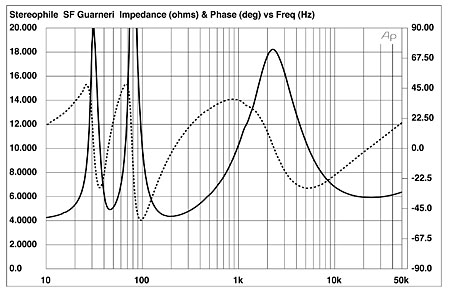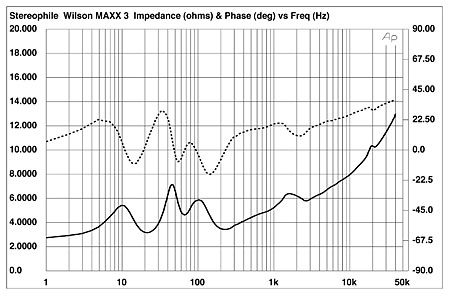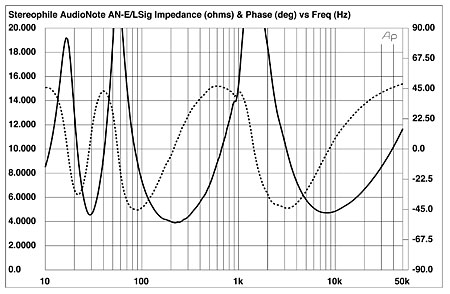
 |
|
#11
|
|||
|
|||
|
Excellent explanation, now I just have to look for a pair of Memento moving up from Cremona M
|
|
#12
|
|||
|
|||
|
Thank you guys. I know SET is designed for high efficiency speakers. But what about LAMM? Their SETs are often paired with huge Wilson with multiple drivers and yet they sound sublime? Doesn't robust power supply play a huge factor as well?
|
|
#13
|
|||
|
|||
|
Quote:
   I've also experimented with the GMs with tubes, SS and tubes and SS with active crossover+subs. I still think that the best approach is either a nice, refined sounding SS amp or tubes of adequate power, not SET with these speakers. |
|
#14
|
|||
|
|||
|
Very well. Appreciate the lessons.
Now, why would SF make speakers with such terrible impedance swing 
|
|
#15
|
|||
|
|||
|
Quote:
 I have yet to see a speaker that is better behaved than the Peak Consult brand. 
|
|
#16
|
|||
|
|||
|
I took a quick look at GE measurements from Stereophile and it swings as much as GM does.
|
|
#17
|
|||
|
|||
|
Quote:
I think it is worthwhile trying to understand the implications of the graphs. Firstly, a rising impedance doesn't cause any problems for amps. And particularly for valve amps. So ignore everything above 8 ohms, and look below that. Secondly, it is the combination of large phase angle and low impedance that is most demanding. So where the phase angle line crosses the impedance line, in an area of low impedance, is where a low powered valve amp, such as a SET, can have trouble controlling the speaker. In the GM, this happens at around 120Hz. But the impedance here is still well over 5 ohms, so not too tough. The lowest impedance, which occurs around 200Hz, is still a bit over 4 ohms, which any decent SET can easily handle. Here is another of John's graphs for a speaker specifically designed for SET, the Audio Note AN-E:  Not so different from the GM!  In fact, looking at these graphs, I would say that the GM is even easier for a SET to drive than the AN speaker. But the issue will be volume and dynamic range. The GM has low sensitivity at 86dB at 2.3v from 1 metre distance. Which means, with a typical 300B SET, a peak of around 95dB. That is quite loud, but most of us listen from further than 1 metre away, so there will be a volume drop off. Also, orchestral music often has at least a 25dB dynamic range. So the low listening level would be around 70dB. But within that narrow operating range, I am sure the GM will sound magnificent with a good SET - particularly in the midrange where all magic resides. And the defining character of a good SET is largely determined by the quality of its output transformers. Which are also the single most expensive component in any amplifier parts list. I have a pair of SF Minima Amator which sound fantastic with my Wavelength Audio 300B. The Minima Amator are my longest surviving audio component, and I will never part with them. I am currently using Audio Note AN-J with my Wavelength, but prefer the mid band with the Minima Amator. The main reason for me is room positioning. A SET is going to work better in a smaller room than a larger one, unless using horn speakers or such. The Audio Note speakers sound best tucked in the corners. The SF stand mount speakers need to be well out in the room to integrate the upper bass. Not so practical in many smaller rooms. As others have said, the GM with a good solid state amp will be a much more versatile system. But as much as I love my extremely versatile Amati Futura / Burmester system, it does not replace the midrange magic of the Minima Amator with a SET. The best compromise is to have both 
|
|
#18
|
||||
|
||||
|
Quote:
Thank you. Howie |
|
#19
|
||||
|
||||
|
Quote:
 Now let's look at bit more closely. First, the output at 1 meter is typically significantly higher than at the listening position. How much more depends on the room/speaker setup and listening position but certainly >6dB, likely more. Second, not all SETs are created equal. Most are not at all adept at driving the speaker portrayed in that graph in anything resembling an acceptable manner. Some exceptions are. For instance, an amp that halves its power between 8 and 4 ohms, you will have sonic issues. For those enamoured of the magic midrange it may not matter - for those concerned with musical coherence and dynamic linearity, it likely will (does) in the real world. Without knowing what "well out into the room" means, it's hard to comment on Memento positioning. Certainly standmount Sonus speaker do not need that (again depending on what that is), but they become extremely precise in their requirements the closer you are to boundaries. Certainly if one sets up speakers using a tape measure, then getting away from the boundaries will minimize the mismatched bass that is typically exacerbated by the boundary proximity being acoustically unbalanced. In speaker placement, an inch is as close as a mile. Certainly proper treatment of a smaller room will allow it's use closer to boundaries, but like most Sonus faber standmounts, it certainly opens up in the mids and top out into the room, all other things being equal. Don't get me wrong. As the saying goes, "you pays your money and you takes your choice." But if I'm using tubes on any Guarneri, and I almost always do, I'm looking to push-pull first. The next SET I find that works for me on Guarneris will be the first. However, I must admit that results caused me to stop looking very hard a long time ago. As always, YMMV. |
|
#20
|
|||
|
|||
|
Quote:

|
 |
|
|
| Audio Aficionado Sponsors | |